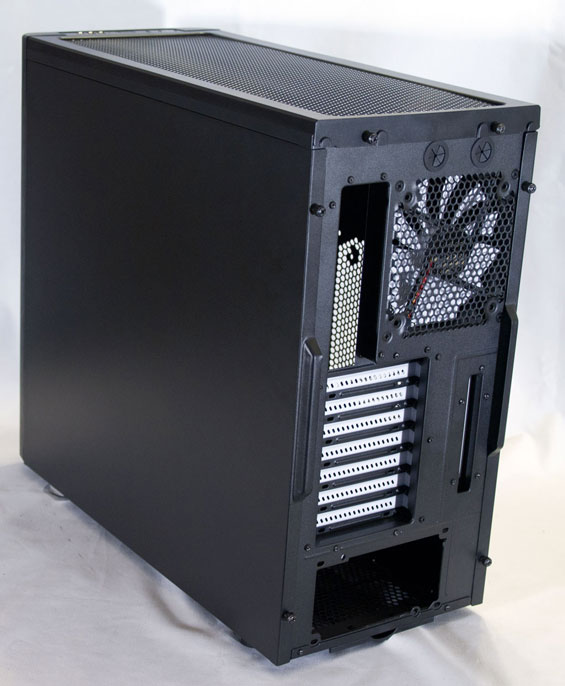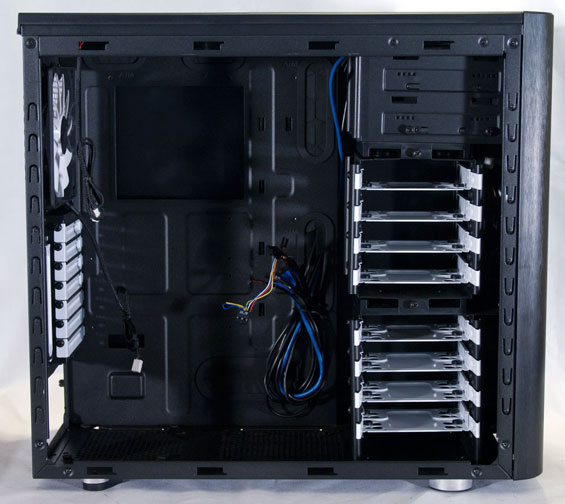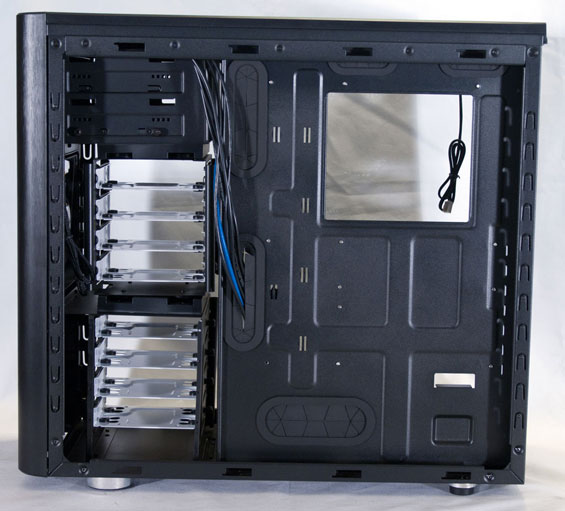Fractal Design Arc Midi: The Mid Tower You've Been Waiting For?
by Dustin Sklavos on October 7, 2011 12:45 AM EST- Posted in
- Cases/Cooling/PSUs
- mid-tower
- Fractal Design
In and Around the Fractal Design Arc Midi
Good artists borrow, great artists steal, and excellent case designers are like Dr. Moreau, fusing elements from different competitors together to produce something the market has really been asking for. In that vein, Fractal Design's Arc Midi borrows a lot of fantastic ideas from a few different places and comes up with something very special.
First, I'm a huge fan of the aesthetic. While the front is only given the appearance of brushed aluminum (all of the advertising material calls it a "brushed aluminum like look"), that's actually almost better than just using brushed aluminum on just one part. I also like the choice to use just two 5.25" external bays and the discreet row of I/O and buttons at the top of the case. By only putting in two bays, Fractal Design frees up most of the front of the enclosure for air intake. The way the grille is recessed into the bezel is particularly pleasing, and this is a design cue that extends to the top of the enclosure. Note that both the front panel and the top grill are removable to allow the user to clean the fan filters as well as mount additional fans.
I do think this is the first time I've ever been unhappy to see a side intake fan vent, though I probably wouldn't be as bothered by it if Fractal Design had included a fan. Because of how nice the case looks otherwise, that vent breaks up the style a bit. It's a sacrifice for practicality's sake but aesthetically it's a little disappointing.

When you get to the back of the Arc Midi you'll see Fractal Design opted for white accents for the fan blades and the ventilated expansion slot covers. I actually really like the "7+1" expansion slot design, where there are seven in a row and then an eighth mounted laterally above the others. This is something Fractal Design seems to have borrowed from Cooler Master, and it's a great choice, giving you a place to mount the fan controller without having to sacrifice any expansion slots on the motherboard. I'm ultimately a bigger fan of eight expansion slots in a row, but this is still appreciated in a mid tower.

Opening up the Arc Midi reveals a thoughtful interior that takes a lot of cues from Corsair while improving a bit on their design. Fractal Design includes two drive cages with four drive sleds each, and the top drive cage can actually be either rotated ninety degrees or removed entirely. In the default configuration, the metal drive sleds (metal instead of cheap plastic!) orient the drives facing behind the motherboard tray.

That space behind the motherboard tray is another area where Fractal Design one-ups a lot of the competition: it's copious. The rubber-lined grommets surrounding the routing holes in the tray also stay in place; with other cases I've often just removed these because they've come loose so easily, but in the Arc Midi they're in relatively firmly and I never had any of them pop out during assembly.
It should be pretty obvious that I'm a big fan of how the Arc Midi is laid out. Fractal Design has taken some good exterior aesthetic ideas and combined them with an improved interior that ought to make Corsair take notice. Corsair has traditionally been my benchmark for ease of assembly, but the Arc Midi has all the earmarks of a smart internal design.
















52 Comments
View All Comments
lwatcdr - Friday, October 7, 2011 - link
How about a case shoot out with a difference.How about the Fracal Design Arc Midi vs the BitFenix Merc Alpha?
Except spend $60 on upgrading the Alpha. Use the money to put in better fans and such.
Now hear me out before people jump on me.
For a lot of builders they enjoy the act of building and improving. So it would be interesting to see if a hobbiest would be better off modding the Alpha vs buying the Midi.
You can do the same thing with the Midi vs a more expensive case
Death666Angel - Friday, October 7, 2011 - link
I like the case. I might recommend it or the smaller brother, Arc Mini.However, I personally don't understand the obsession with:
a) tool less installation in general and
b) tool less installation of drives especially.
I don't assemble / tear apart my cases that it is a big concern. And having actual screws to tighten gives me a better feeling. Depending on the approach, tool less drive assembly might also inhibit my ability to install non-drive stuff in the cages, for example water cooling equipment, fan controllers, back planes etc., when they use non-standard holes.
This stuff may be important for big OEM who assemble millions of PCs. But for me as someone who assembles PCs for myself and friends and family, I see no reason to go with tool less, if I can avoid it. :-)
But a good review overall! And I like that you guys are tackling a lot of normal-budget cases. I don't see the appeal in huge 200 to 300USD cases that can house 10 HDDs and 4 GFX cards. :D
bhima - Friday, October 7, 2011 - link
I'm sort of glad the noise levels were only OK, it makes my purchase of an Antec 902 feel I little bit more justified.bunnyfubbles - Friday, October 7, 2011 - link
plenty of space for a mid tower build and was easily one of the most pleasurable experiences I have ever had when actually putting the computer together, I can't really recall any instance where I was stumped or struggled on how or where i was going to route my cable managementhttp://img199.imageshack.us/img199/2272/dsc0120tq....
moved the top 140mm fan to the front to have dual 140 intakes and make room for the 240mm rad of the H100, and added an aftermarket NZXT 140mm to the bottom as an intake
right now my biggest gripe is the side panel which allows for either at 140mm or 180mm fan could be improved as the 200mm round fans have mounting holes that are actually in between the 140mm and 180mm dimensions they provide and thus are simply not an option to install without some sort of mod.
A filter would also be nice for the side panel otherwise I'm more inclined to use it as an exhaust but that would likely upset positive pressure
all in all it has easily been one of my absolute favorite cases to work with thus far, I'm tempted to buy another and convert some old systems
cjs150 - Monday, October 10, 2011 - link
That is one very nice clean build. I think I can spot my favourite Gentle Typhoons on the Rad.Do you need that many intake fans? Personally I would be tempted to pop in a thick 140mm rad at bottom (or front if you are not using the drive cage) a cool the GPU and CPU. But that is the problem with water cooling - once you start it is difficult not to tinker
Malih - Friday, October 7, 2011 - link
I finally swing to Fractal Design after reading this review and seeng the build quality of the Arc Midi, and reading several other reviews,but I was looking to build a silent system, and I also think about microATX system, so I decided to get the Define Mini, there's a "bug" in the case regarding multi-GPU setup, but since I'm not thinking of going multi-GPU (budgetwise), I decided to get the Define Mini.
radium69 - Saturday, October 8, 2011 - link
When are you guys going to review the Xigmatek cases?They a lot of midi towers that are very sleek and considered to be big value.
Cheers,
Kevin
Zebo - Sunday, October 9, 2011 - link
Just another el cheapo paper thin case. I have not seen a good case since wave master had like 3mm thick aluminum everywhere.snapdrag0n - Sunday, October 9, 2011 - link
CM Storm still the best pound for pound at this price range.Bazzatron - Tuesday, October 11, 2011 - link
The Fractal Design Define R3 is about the same price here in the UK. (About £75)Weighs a ton - combined with a "Be Quiet" PSU is the most silent PC I've ever built
Very impressed with this case